Related Research Articles

A wedding is a ceremony where 2 people are united in marriage. Wedding traditions and customs vary greatly between cultures, ethnic groups, religions, countries, and social classes. Most wedding ceremonies involve an exchange of marriage vows by a couple, presentation of a gift, and a public proclamation of marriage by an authority figure or celebrant. Special wedding garments are often worn, and the ceremony is sometimes followed by a wedding reception. Music, poetry, prayers, or readings from religious texts or literature are also commonly incorporated into the ceremony, as well as superstitious customs.

The Mosuo, often called the Naxi among themselves, are a small ethnic group living in China's Yunnan and Sichuan provinces. Consisting of a population of approximately 40,000, many of them live in the Yongning region, around Lugu Lake, in Labai, in Muli, and in Yanyuan.
In Hindu culture, the term gotra is considered to be equivalent to lineage. It broadly refers to people who are descendants in an unbroken male line from a common male ancestor or patriline. Generally, the gotra forms an exogamous unit, with marriage within the same gotra being regarded as incest and prohibited by custom. The name of the gotra can be used as a surname, but it is different from a surname and is strictly maintained because of its importance in marriages among Hindus, especially among castes. Pāṇini defines gotra as apatyam pautraprabhrti gotram, which means "the word gotra denotes the descendance, apatya, of a couple consisting of a pautra, a son and a bharti, a mother, i.e. a daughter-in-law." When a person says "I am Vipparla-gotra", he means that he traces his descent to the ancient sage Vipparla by an unbroken male descent.

A Hindu wedding, also known as Vivaha, Lagna (लग्न), Kalyanam or Pelli is the traditional wedding ceremony for Hindus. The wedding ceremonies are very colourful, and celebrations may extend for several days. The bride's and groom's home—entrance, doors, wall, floor, roof—are sometimes decorated with colors, flowers, and other decorations.

Śrauta is a Sanskrit word that means "belonging to śruti", that is, anything based on the Vedas of Hinduism. It is an adjective and prefix for texts, ceremonies or person associated with śruti. The term, for example, refers to Brahmins who specialise in the śruti corpus of texts, and Śrauta Brahmin traditions in modern times can be seen in Kerala and Coastal Andhra.
The following list consists of notable concepts that are derived from Hindu culture and associated cultures traditions, which are expressed as words in Sanskrit or other Indic languages and Dravidian languages. The main purpose of this list is to disambiguate multiple spellings, to make note of spellings no longer in use for these concepts, to define the concept in one or two lines, to make it easy for one to find and pin down specific concepts, and to provide a guide to unique concepts of Hinduism all in one place.
Hindu traditions right from Ramayan to till date cremate their dear ones, burying the dead is in some sections of the society. But the majority of Hindus cremate the dead as they believe that the body is made up of 5 elements which after cremation will mix in the pancha bhootas,

Sitara Devi was an Indian dancer of the classical Kathak style of dancing, a singer, and an actress. She was the recipient of several awards and accolades, and performed at several prestigious venues in India and abroad; including the Royal Albert Hall, London (1967) and at the Carnegie Hall, New York (1976).

Antyesti literally means "last sacrifice", and refers to the funeral rites for the dead in Hinduism, which usually involves cremation of the body. This rite of passage is the last samskara in a series of traditional life cycle samskaras that start from conception in Hindu tradition. It is also referred to as Antima Sanskar, Antya-kriya, Anvarohanyya, or as Vahni Sanskara.

The Hindu marriage is the most important of all the samskaras, the rites of passage described in the Dharmashastra texts.
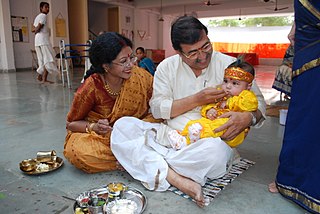
Samskara are sacraments in Hinduism and other Indian religions, described in ancient Sanskrit texts, as well as a concept in the karma theory of Indian philosophies. The word literally means "putting together, making perfect, getting ready, to prepare", or "a sacred or sanctifying ceremony" in ancient Sanskrit and Pali texts of India.
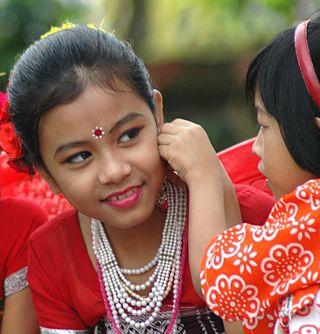
The Tripuri culture of North-East India has many distinctive features.

Punjabi wedding traditions are a strong reflection of Punjabi culture with ritual, song, dance, food, and dress that have evolved over centuries.
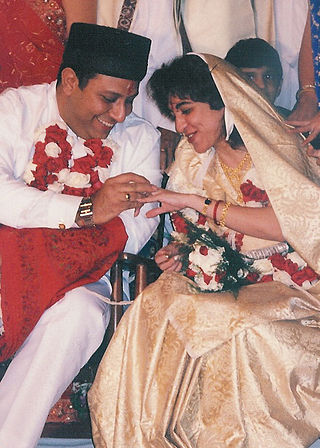
Zoroastrian weddings are a religious ceremony in Zoroastrianism in which two individuals, a man and a woman are united. In Zoroastrianism, marriage within the community is encouraged, and is greatly favored in religious texts. The following information will detail ceremony procedures and traditional processes for a Zoroastrian wedding.
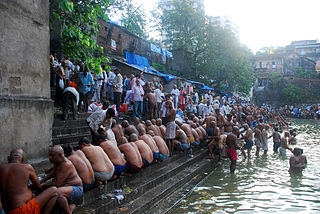
Pitru Paksha is a 16–lunar day period in Hindu calendar when Hindus pay homage to their ancestors (Pitrs), especially through food offerings. The period is also known as Pitri Paksha/Pitr-Paksha, Pitri Pokkho, Sorah Shraddha, Kanagat, Jitiya, Mahalaya, Apara Paksha and akhadpak, Pitru Pandharavda or pitru paksh.
The Lonari caste are found chiefly in India regions of Bhusawal, Jalgaon, Dhule, Surat, Ahmednagar, Aurangabad, Khandesh, Nasik, Pune, Baramati, Indapur, Sangli, Satara, Solapur, Jalna, the Satara agency, and the southern Maratha country. The caste had a population of 19,222 in 1901, which included 9,672 males and 9,550 females. They are a caste of cement–makers and lime burners who were once believed to be Marathas & later formed themselves into a separate class by adopting the occupation of lime and charcoal makers /traders. Lonari's originally never had any caste reservations & belonged to general (open) category but later were granted a OBC status in mid 90's in state of Maharastra. In Belgaum district they are divided into Mith (salt) and Chuna (lime) Lonaris, who eat together but do not intermarry. In Ahmednagar, Poona, and Solapur district, they are divided into Lonari proper and Kadu, Akaramashe, who eat together but do not intermarry.mainly kshtriya lonaries are maratha but due to political influence and having good leader they decided to go in OBC cast when circular came also one important thing in current situation caste people situated all over india like Karnataka, Madhya Predesh, Gujarat, etc but mainly people of this caste is from Maharashtra and given their huge tribute with army of Shivaji Maharaj to fight against Mughal Army. Their origin is from Maharastra from ancient time.
Pumsavana Simantonayana is a combined performance of the two Hindu rites of Pumsavana and Simantonnayana, practised during the contemporary period.
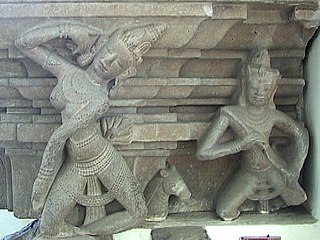
A Gandharva marriage is one of the eight classical types of Hindu marriage. This ancient marriage tradition from the Indian subcontinent was based on consensual acceptance between two people, with no rituals, witnesses or family participation. The marriage of Dushyanta and Shakuntala was a historically celebrated example of this class of marriage.

The Telugu Hindu wedding ceremony is the traditional wedding ceremony of the Telugu people in India. In the 19th century, the ceremony could last up to sixteen days. In modern times, it can last two or more days, depending on the family's financial and social status. The pelli or wedding is considered the strongest of social bonds, and is said to spiritually merge two souls opening the doors to gruhastaashramam. There is a Telugu saying that "Marriage is supposed to be a family union and not an individual formality." However, with changing mindset of the younger generation and due to globalization, marriage these days is being mainly focused solely on the union of the young couple only.
Bahaghara is a wedding ceremony performed by Odia Hindu people in the Indian state of Odisha. There are subtle differences in the rites observed by different castes. In Odia marriage rituals, the mother of the bridegroom does not take part in the ceremony. The Utkala Brahmins have their weddings only in the daytime, preferably at midday or in the morning, while the other caste weddings are done during the evening or night. There is the custom of sending betel nuts to family friends for inviting them to the marriage. The first invitation is sent to the family deity as a respect to the lord. Marriages in Odisha are mostly fixed and arranged by the parents. Marriages for serving or capturing is not common. In the Odia community widow remarriage is allowed in some lower caste, in this case the younger brother is allowed to marry the deceased brother's wife. The marriage happens in three major rituals, Nirbandha, Bahaghara (wedding) and Chauthi (Chaturthi) (consummation). A marriage is not considered complete or valid until consummation. These rituals are performed either at the Duara or Tola kanias house.